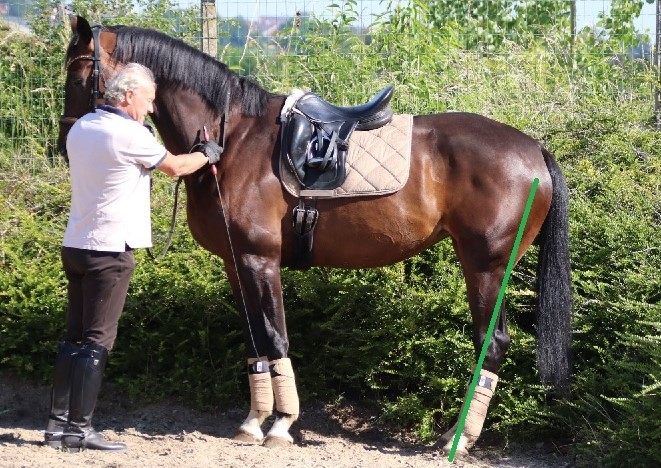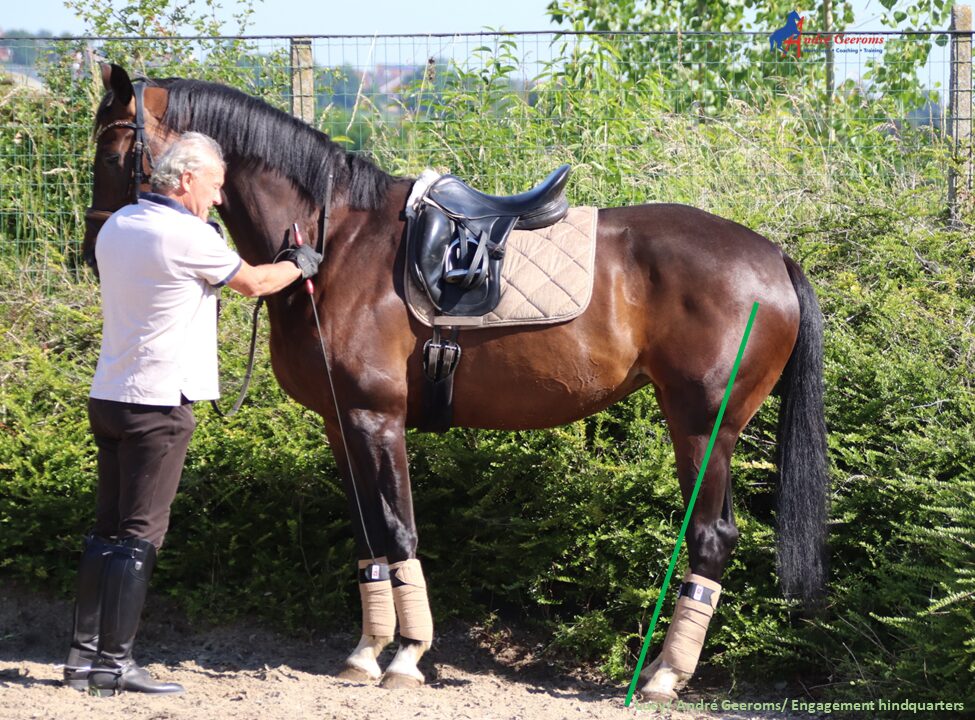
Showing foreleg
But can't you see, Dré, that my beautiful foreleg is disappearing because of all the collected work you are forcing on me?
Je hebt gelijk Lucy, ik heb opgemerkt dat je een heel mooi voorbeen hebt, zeker als ik je op je eigen manier laat draven. Moest ik op dit moment met jou bij de jonge paarden op wedstrijd gaan, dan zouden wij zeker niet hoog schoren, dat weet ik wel. Want vele jury’s en het kennerspubliek worden toch gefascineerd door dat hoog en ver uitzwaaiend voorbeen. Ik ben niet anders hoor Lucy, maar ik zou willen dat je mooie voorbeen er komt vanuit een dragend ondertredende en soepele achterhand.
Neen, neen, ik ga je nu niet als gek uitgestrekte draf door je strot duwen. Van zo’n uitgestrekte draf filmpjes krioelt het in de sociale media. Zo’n paarden worden meestal in vluchtmodus gebracht door knallende zwepen, wetende dat geëxciteerde paarden imponeergedrag vertonen en dus ferm van de grond gaan. Paarden die zo tijdens hun jonge jaren rondgejaagd worden leren heel veel stuwing met de achterhand te vertonen, wat na zoveel herhaling een automatisme wordt. De meeste van deze showbeesten zullen het in hun latere africhting knap lastig krijgen om later in hun carrière verzamelde oefeningen zoals piaffe en pirouettes te kunnen uitvoeren. Logisch toch, want aan het ontwikkelen van de voor verzameling noodzakelijke spieren (Buikspieren, Hasenspier, en een serie andere spieren waarvan ik de naam niet ken) is nooit aandacht besteed.
So yes, Lucy, your beautiful front leg will have to emerge later under my guidance, but from a carrying hind leg and with elevation. And we are going to start to work an this?
Attention to the active hind leg
De natuur heeft je minder bedeeld met een aanleg voor verzameling, en ja, hieraan gaan we dus samen wat meer moeten werken. Oh, juist ja, je kan nogal wat protest tonen als ik de aanzet naar verzameling vraag? Denk maar aan de overgangen tussen de verschillende gangen, waaraan wij toch al veel tijd hebben besteed. Ook aan de zijgangen hebben wij al heel wat tijd gespendeerd, dit om ‘één’ specifiek achterbeen (Het binnen achterbeen natuurlijk) naar je zwaartepunt toe te laten werken. En ik moet toegeven dat wij deze zijgangen reeds goed beheersen, zowel aan de hand als bereden. Maar vanaf nu wens ik die ‘beide’ achterbeentjes er onder te krijgen en dat gaan wij je nu natuurlijk ook op de rechte lijnen leren. Bij gebogen lijnen en zijgangen is er steeds maar één achterbeen dat meer geactiveerd wordt dan het andere.
Choosing in hand or mounted
Aangezien je tijdens het bereden verzamelde werk toch gemakkelijk je ongenoegen naar mij uit, zullen wij het werk aan de hand hiervoor als eerste gebruiken. Ja, voor mijn gemak doen we dat in de stap, ik beschik niet meer over de nodige vermogens om naast jou rond te draven. Door naast jou te staan kan ik mijn goed ontwikkelde visuele voorkeursyteem ten volle gebruiken en veel aandacht besteden aan je ondertredende achterhand en de oprichting van je hals.
Ja Lucy, protesteren helpt niet, hoofdje naar boven en achterbeentjes eronder, geen andere weg mogelijk. Leuk om vast te stellen dat je op de aanraking met de dressuurzweep, op de plaats waar normaal mijn kuit ligt, dadelijk je gelijkzijdige achterbeen naar voor trekt. Ik heb tijdens de voorbij maanden reeds geleerd dat deze aanraking gevolgd wordt door een tikje met hogere intensiteit op je achterbeen, wanneer je niet direct reageert. Dat tikje kan ik nu gebruiken om tot verzameling te komen.
Going backwards also improves the collection
Maar ik ben ook niet bang om je de hele lange zijde te laten achteruitgaan, Lucy. De biomechanica leert ons dat je de beide achterbenen meer voorwaarts dient te brengen om überhaupt je massa naar achter te kunnen slepen met je achterbenen. Ja, je voorbenen dienen enkel om het grootste deel van je gewicht te dragen tijdens het kantelmoment en hebben maar weinig toegevoegde waarde in het voortbewegingsproces. Duidelijk een goede turnoefening om de spieren van je achterbenen en je rug tot verzameling te kunnen aanzetten.
En ja hoor, achteruit begeleid ik je ook tot diep in de hoek, zover dat je achterhoeven niet meer achteruit geraken. Je hoofd en hals zal ik door mijn halve ophoudingen ook opwaarts houden, want anders zou een deel van het beoogde resultaat verloren gaan. In deze ondergeschoven achterhand positie laat ik je dan ook een paar minuutjes in de hoek halthouden. Dit noemt men statische arbeid en dat is ook goed voor het ontwikkelen van de beoogde spieren die tot verzameling moeten leiden.
Combining 'in hand' and 'mounted'
Na het beëindigen van dit 20 minuten durende intensieve grondwerk proberen wij bereden dadelijk juist hetzelfde werk te doen. Natuurlijk dient eerst wat protest weggewerkt worden, want met een iets te zwaar wegende ruiter op je rug is alles toch nog wat moeilijker om uit te voeren. Neen Lucy, ik ben niet van plan om één of andere ‘slender you’ cursus te volgen om drastisch af te vallen. Maar ik zal jouw lichaam en geest helpen ontwikkelen om deze verhoogde inspanning te kunnen leveren. Want ik wil naast paardrijden toch ook wat ander genot in het leven blijven behouden. Niks mis mee, althans volgens mijn opvatting.
Developing variuos types of trot
But also in the collected trot I whish to see the same exercise from you Lucy. And by collected trot I mean a very short and active trot, yes with small impulsive steps, as the Iberian horses show very easily. This collected trot will also cole in handy later when learning the piaffe. And no, I do not whish to see a slow trot appearing with big steps now, this is for later when we are working towards the cadenced trot.
As you notice, Lucy, I intend to put a lot of work before you can call yourself a real dressage horse.
Meer hippische interesse?
Doorlaatbare dressuurlessen krijgen
